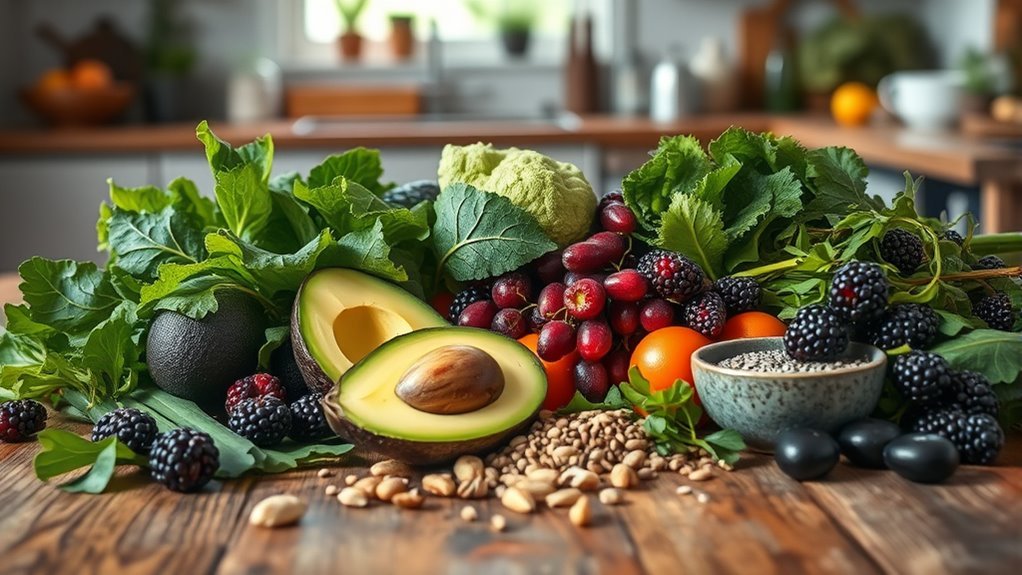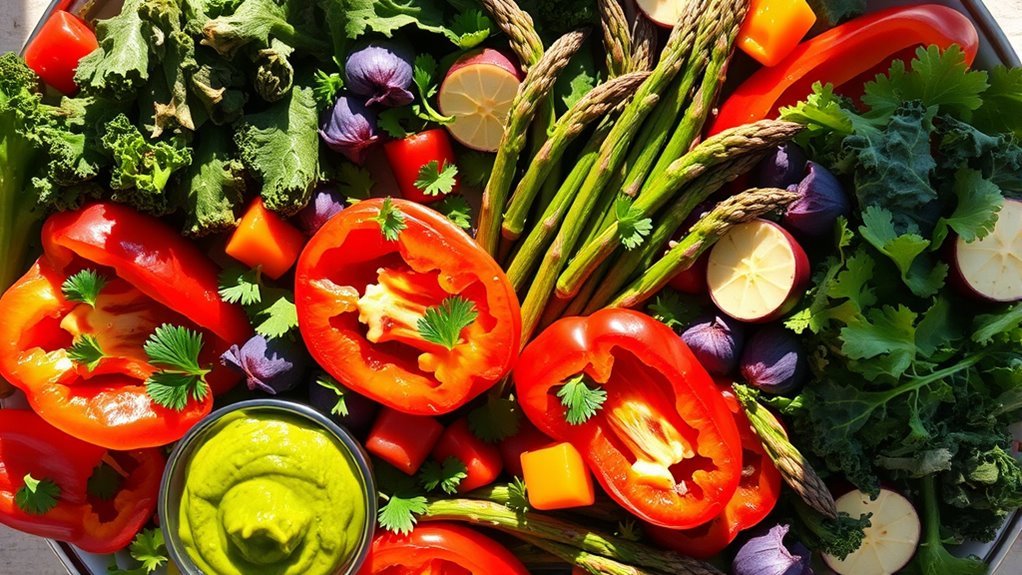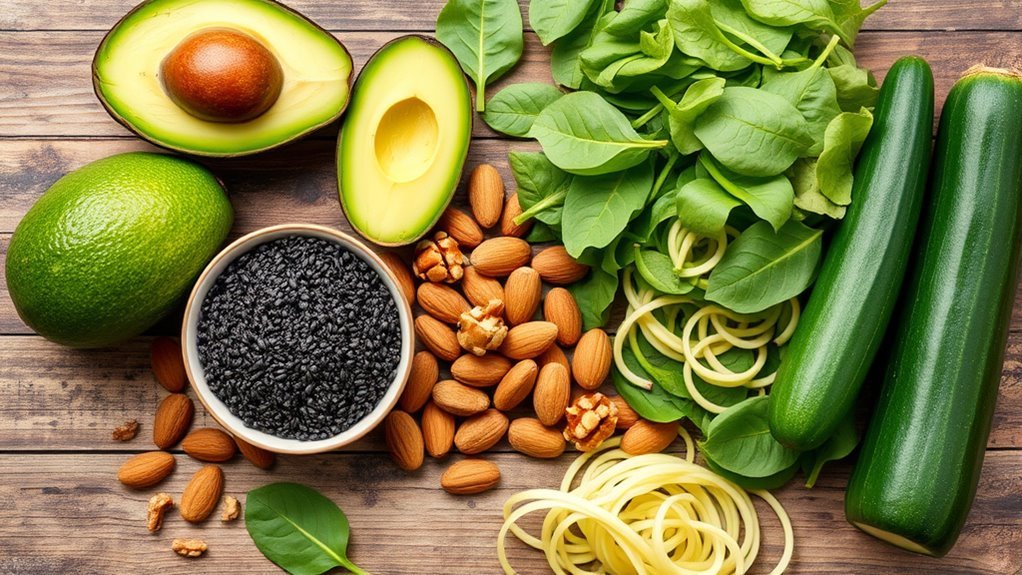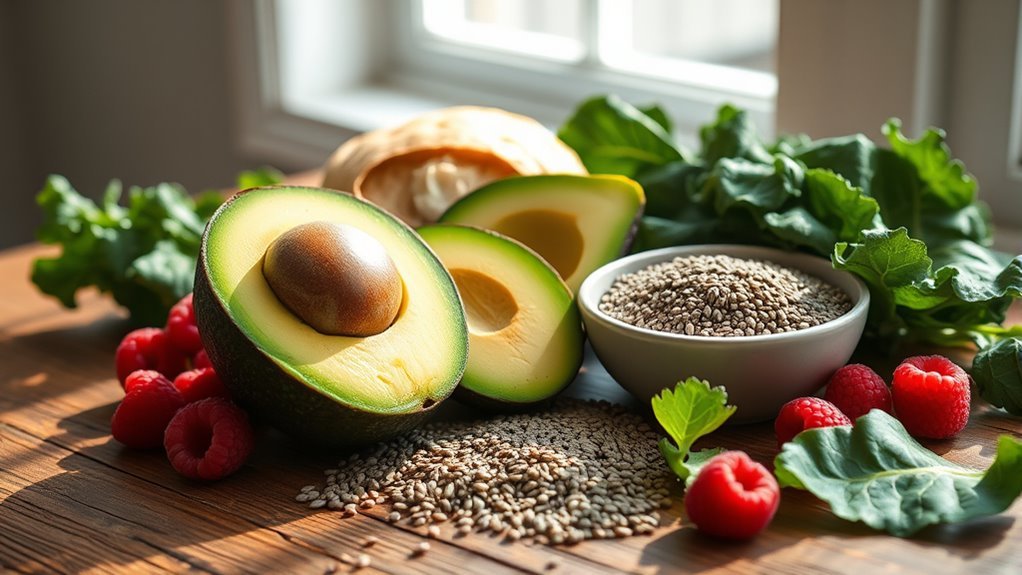To get fiber on a keto diet, focus on low-carb vegetables like spinach, broccoli, and zucchini. Incorporate nuts and seeds, such as chia seeds and flaxseeds, which add fiber and healthy fats. Avocados are also a fantastic source, providing about 10 grams of fiber each. Consider using psyllium husk as a supplement to boost your intake without raising carb levels. By prioritizing these foods, you’ll enhance your digestive health while sticking to your keto goals. More tips await you!
Understanding Fiber and Its Importance on a Keto Diet

When you’re following a keto diet, understanding fiber’s role is vital for maintaining overall health. Fiber supports digestive health, helping to prevent issues like constipation that can arise when you’re consuming fewer carbs. Since traditional high-fiber foods like grains and many fruits are off-limits, it’s important to seek alternative fiber sources. Consider incorporating seeds, nuts, and low-carb legumes into your meals. These options not only provide fiber but also deliver healthy fats and protein, aligning perfectly with your keto goals. Additionally, don’t overlook the benefits of fiber supplements if needed. Prioritizing fiber intake can empower you to feel better and more energetic while enjoying the flexibility of a keto lifestyle, ensuring your body runs smoothly and efficiently.
Low-Carb Vegetables Rich in Fiber

Incorporating low-carb vegetables rich in fiber is essential for a balanced keto diet. These veggies not only help you meet your fiber needs but also keep your carb intake in check. Consider adding these to your meals for a delicious and nutritious boost:
- Spinach: A powerhouse of vitamins and fiber, perfect for salads or smoothies.
- Broccoli: High in fiber and low in carbs, this veggie adds crunch and nutrition to your dishes.
- Zucchini: Versatile and hydrating, it’s great for stir-fries or as a noodle substitute.
Don’t forget about fiber-rich herbs like parsley and basil—they can elevate your meals while providing additional nutrients. Embrace these keto-friendly greens to enjoy both freedom and health on your keto journey!
Nuts and Seeds That Provide Fiber

Adding nuts and seeds to your keto diet can greatly boost your fiber intake while keeping carbs low. These nutrient-dense options not only provide fiber but also come with various health benefits. Here’s a quick overview of some nut varieties and their fiber content:
| Nut/Seed | Fiber (per 1 oz) |
|---|---|
| Chia Seeds | 10g |
| Almonds | 3.5g |
| Flaxseeds | 8g |
Incorporating these high-fiber foods can support digestion and help you feel full longer. Plus, seed benefits include healthy fats and essential nutrients. By choosing the right nut varieties and seeds, you can enjoy a satisfying, fiber-rich keto lifestyle without feeling deprived.
Avocado: A Fiber Powerhouse
Although many people think of avocados as just a healthy fat source, they’re also a fantastic source of fiber, making them a perfect addition to your keto diet. With about 10 grams of fiber per avocado, they offer valuable avocado benefits that support digestive health and satiety.
Avocados are not just healthy fats; they also provide 10 grams of fiber, enhancing your keto diet and supporting digestive health.
Consider the following:
- Creamy texture that enhances salads and smoothies
- Versatile flavor that pairs well with both savory and sweet dishes
- Nutrient-dense profile packed with vitamins and minerals
Incorporating avocados into your meals not only boosts your fiber sources but also keeps you feeling full longer, allowing for more freedom in your food choices. So, enjoy a slice on your keto toast or blend it into your favorite dip for a delicious fiber boost!
Incorporating Chia and Flaxseed Into Your Meals
Chia and flaxseed are excellent sources of fiber that can enhance your keto meals while providing essential nutrients. Incorporating them into your diet is simple, with plenty of easy recipe ideas to get you started. Let’s explore the nutritional benefits and some practical ways to use these seeds in your everyday cooking.
Nutritional Benefits Overview
Incorporating nutrient-dense seeds like chia and flaxseed into your meals can greatly enhance your fiber intake on a keto diet. These seeds are excellent fiber sources that promote digestive health and keep you feeling full longer, aligning perfectly with your low-carb lifestyle.
Consider these benefits:
- Chia seeds: Packed with omega-3 fatty acids, they absorb water and expand, making them a satisfying addition to any dish.
- Flaxseeds: Rich in lignans, they support hormonal balance and are a great source of protein.
- Versatile usage: Blend them into smoothies, sprinkle on salads, or mix into keto-friendly baked goods for added crunch.
Embrace these seeds to boost your fiber intake while enjoying delicious meals!
Easy Recipe Ideas
Adding chia and flaxseed to your meals can be both simple and delicious, making it easy to boost your fiber intake on a keto diet. For quick fiber rich snacks, try mixing chia seeds into your favorite nut butter and spreading it on celery sticks. You can also sprinkle flaxseed on salads or yogurt for an added crunch. Another great option is to blend both seeds into keto friendly smoothies; combine unsweetened almond milk, spinach, and a tablespoon of chia or flaxseed for a nutrient-packed drink. These small additions not only enhance texture and flavor but also provide essential omega-3 fatty acids and fiber, helping you stay full longer while keeping carbs low. Enjoy the freedom of tasty, nutritious meals!
The Role of Psyllium Husk in Fiber Intake
Psyllium husk is a powerful source of soluble fiber that can help you maintain digestive health while on a keto diet. Its health benefits include promoting regularity and supporting heart health, making it a valuable addition to your meals. You can easily incorporate psyllium husk into recipes like smoothies, baked goods, or even as a thickener for soups.
Health Benefits of Psyllium
While maneuvering a keto diet, you might find it challenging to meet your fiber needs, but psyllium husk can be a valuable ally. Not only does it help maintain digestive health, but it also offers several compelling psyllium benefits:
- Promotes regularity: Psyllium absorbs water, forming a gel-like substance that aids in smooth bowel movements.
- Supports gut health: It acts as a prebiotic, nourishing beneficial gut bacteria and enhancing overall digestive function.
- Reduces cravings: By increasing feelings of fullness, psyllium can help curb those pesky snack attacks, keeping you focused on your keto goals.
Incorporating psyllium husk into your routine can empower you to enjoy the freedom of a keto lifestyle without sacrificing essential nutrients.
Incorporating Psyllium Into Meals
To effectively boost your fiber intake on a keto diet, incorporating psyllium husk into your meals can be a game-changer. This soluble fiber not only aids digestion but also helps maintain a feeling of fullness. You can easily add psyllium to your daily routine with simple psyllium recipes. For instance, mix it into keto-friendly baked goods or even sprinkle it on salads for an added crunch. Psyllium smoothies are another great option; blend it with low-carb fruits and vegetables for a nutritious drink that keeps you satisfied. Just remember to drink plenty of water when using psyllium, as it absorbs liquid and expands in your digestive system, ensuring ideal benefits. Enjoy the freedom of delicious, fiber-rich meals!
Low-Carb Fruits That Won’t Break Ketosis
If you’re looking to satisfy your sweet tooth without jeopardizing your ketosis, incorporating low-carb fruits into your diet can be a game changer. These keto-friendly fruits are not only delicious but also packed with nutrients, allowing you to enjoy nature’s candy while staying within your carb limits. Consider adding these low carb berries to your meals:
- Raspberries: Bursting with flavor and only 5 grams of net carbs per cup.
- Blackberries: A rich source of antioxidants, containing about 6 grams of net carbs per cup.
- Strawberries: Sweet and satisfying with just 7 grams of net carbs per cup.
Tips for Increasing Fiber Without Increasing Carbs
Incorporating low-carb fruits into your keto diet is a delightful way to enjoy natural sweetness, but it’s also important to guarantee you’re getting enough fiber to support digestive health. To boost your fiber intake without increasing carbs, consider adding chia seeds or flaxseeds to your meals; they’re low in carbs but high in fiber. Leafy greens like spinach and kale are also fantastic options. Additionally, don’t overlook the benefits of fiber supplements, which can provide a quick and convenient way to meet your daily fiber needs. Always choose those that are keto-friendly. By mixing these strategies into your meals, you’ll enhance your fiber intake while maintaining your carb limits, supporting your overall digestive health on a keto journey.
Monitoring Your Fiber Intake on a Keto Diet
While following a keto diet, it’s vital to keep an eye on your fiber intake to make certain you’re meeting your digestive health needs. Fiber tracking becomes important alongside carb counting to confirm you’re getting enough roughage without exceeding your carb limits.
Consider incorporating these high-fiber, low-carb foods:
- Chia seeds: Tiny powerhouses of fiber that can be added to smoothies or puddings.
- Avocados: Creamy and versatile, they also provide healthy fats.
- Leafy greens: Spinach and kale can be the base of delicious salads or sautéed dishes.
Frequently Asked Questions
Can I Use Fiber Supplements on a Keto Diet?
Absolutely, you can use fiber supplements on a keto diet. They’re a great way to guarantee you’re getting enough fiber, especially since many traditional fiber sources are high in carbs. Look for supplement types like psyllium husk or inulin, which are low in net carbs. Just make certain to check the labels for any hidden sugars. Balancing your fiber intake can help you maintain digestive health while enjoying the freedom of a keto lifestyle.
How Does Fiber Affect Ketosis?
When you think about fiber, imagine it as that trusty guide on a spontaneous road trip. It helps keep your digestive system running smoothly, which is essential for maintaining ketosis benefits. Fiber sources like leafy greens, nuts, and seeds can aid digestion without spiking your carbs. By including these, you can enhance your overall health while enjoying the freedom of a keto lifestyle. So, don’t overlook fiber; it’s your key to a balanced journey!
Is All Fiber Suitable for a Keto Diet?
Not all fiber’s suitable for a keto diet. Soluble fiber, found in foods like avocados and chia seeds, can help you feel full and support digestion without greatly impacting your carb intake. On the other hand, insoluble fiber, found in whole grains and many fruits, might not align with your low-carb goals. It’s essential to choose your fiber sources wisely, focusing on those that fit within your keto lifestyle for ideal health benefits.
What Are the Signs of Fiber Deficiency?
If you’re not getting enough fiber, you might notice signs like constipation, bloating, or irregular bowel movements. These symptoms can negatively impact your digestive health. Incorporating various fiber sources, such as vegetables, nuts, and seeds, can help alleviate these issues. Remember, fiber is essential for maintaining a healthy gut. By ensuring you get enough, you can support your overall well-being and enjoy greater freedom in your dietary choices.
Can Too Much Fiber Disrupt Ketosis?
You might’ve heard that too much fiber can disrupt your ketosis balance, and there’s some truth to that. While fiber sources like leafy greens and nuts are great for digestion, excessive amounts can lead to gastrointestinal discomfort and potentially kick you out of ketosis. It’s all about moderation. Keeping your fiber intake within recommended levels allows you to enjoy the benefits without compromising your low-carb lifestyle. Balance is key for best results!


